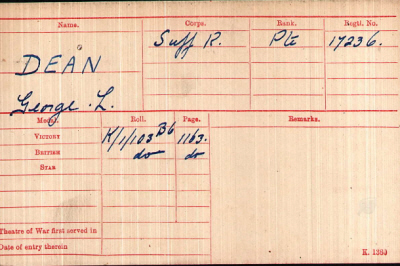



No.17236, Private, George Lazarus DEAN
Aged 36

|
George Lazarus Dean was born in Woodditton in 1882 (Newmarket Q3-1882 3B:512) , son of James and Matilda DEAN (née SCOTT).
"Soldiers Died" have him born at Disby Wood, which seems to be Derisley Wood.
1891 census...Aged 8, he was at Little Ditton, Woodditton with his father James DEAN[44] an agricultural labourer born in Woodditton; his mother Matilda [45] born Kirtling; brother Harry [19] farm labourer born Woodditton and brother Charles [3] born in Woodditton. 1901 census...Aged 18, a stockman on farm, he was in Little Ditton with his parents and brother Charles (Ag.Labourer) 1911 census... Aged 28, a cowman on farm, he was at Stone Cottages, Woodditton with his parents and brother Charles (farm labourer). Of Matilda's seven children, two had died. |

|
He enlisted in Newmarket. Charles died on the 1st day of the Somme, one of nearly 20,000 British soldiers to die in that one terrible day, the worst in British military history. The 11th Suffolks (sometime referred to as the Cambridgeshires) were formed when the numbers of volunteers for the Suffolks overcame the facilities at Bury St Edmunds. A camp was set up in Cambridge to accept attest and accept into the Suffolk Regiment the many men from the edge of the Fens. After a brief time with no official title, they became the 11th Battalion, Suffolk Regiment. From Lt Col Murphy's "History of the Suffolk Regiment" and Ray Westlake's "Tracing British battalions on the Somme", we learn that :- The 11th Suffolks were part of the 101st Brigade, 34th Division which were part of a terrible casualty list. They were mostly very inexperienced troops. Moving up from Becourt Wood early in the morning, they positioned themselves just behind the 10th Lincolnshires. Just in front of them the enormous Lochnagar mine was blown at La Boiselle at 7.28. The Germans, pre warned by the British artillery barrage had simply gone deep into their bunkers, and apart from those actually caught by the mine , were ready and waiting the moment the barrage stopped. The advancing British were cut to pieces by machine fire, it was virtually over for them within half an hour. On that one day the 11th Suffolks suffered 187 killed, of which no less than 146 have no known grave. At the end of July 4th the battalion (around 1,000 men ) had suffered 691 of all ranks either killed or wounded, the highest of any battalion in the 34th Division. |


click here to go to the Commonwealth War Graves Commission website for full cemetery/memorial details